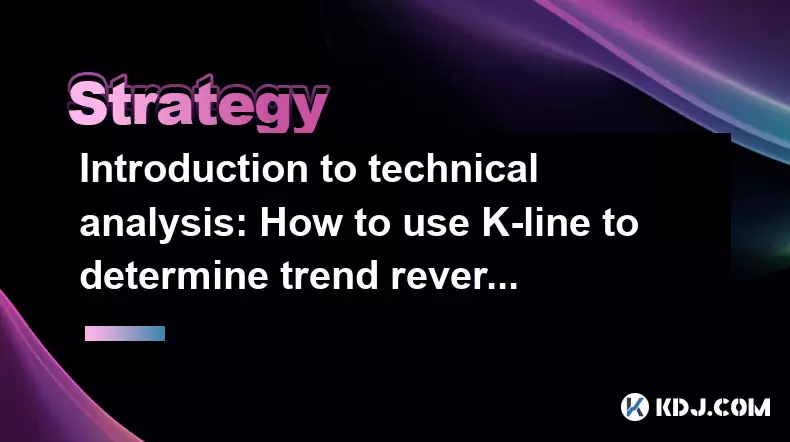-
 bitcoin
bitcoin $123963.239194 USD
1.37% -
 ethereum
ethereum $4529.082464 USD
1.07% -
 xrp
xrp $2.983640 USD
0.71% -
 tether
tether $1.000287 USD
0.02% -
 bnb
bnb $1179.874393 USD
2.99% -
 solana
solana $230.633678 USD
1.55% -
 usd-coin
usd-coin $0.999835 USD
0.03% -
 dogecoin
dogecoin $0.254240 USD
1.34% -
 tron
tron $0.341176 USD
0.15% -
 cardano
cardano $0.842285 USD
0.52% -
 hyperliquid
hyperliquid $48.537896 USD
-0.86% -
 chainlink
chainlink $21.863092 USD
-0.84% -
 ethena-usde
ethena-usde $0.999743 USD
-0.07% -
 sui
sui $3.579561 USD
-0.18% -
 stellar
stellar $0.403418 USD
2.67%
Introduction to technical analysis: How to use K-line to determine trend reversal?
K-line charts help crypto traders spot trend reversals using patterns like hammers and engulfing, confirmed by indicators like RSI and volume.
May 23, 2025 at 11:21 pm

Technical analysis is a critical tool for traders in the cryptocurrency market, offering insights into potential price movements based on historical data. One of the most widely used tools in technical analysis is the K-line, also known as candlestick charts. These charts provide a visual representation of price movements within a specific time frame, allowing traders to spot patterns and make informed decisions. In this article, we will explore how to use K-line charts to determine trend reversals in the cryptocurrency market.
Understanding K-line Charts
Before diving into trend reversal identification, it's crucial to understand the basics of K-line charts. Each K-line represents the price action of a cryptocurrency over a set period, which could be a minute, an hour, a day, or even longer. A K-line consists of a body and two wicks (or shadows). The body shows the opening and closing prices, while the wicks indicate the highest and lowest prices during the period.
- Green (or white) bodies indicate that the closing price was higher than the opening price, suggesting bullish sentiment.
- Red (or black) bodies indicate that the closing price was lower than the opening price, suggesting bearish sentiment.
The length of the body and the wicks can provide additional insights into market volatility and the strength of price movements.
Identifying Key Reversal Patterns
To determine trend reversals using K-line charts, traders often look for specific candlestick patterns. These patterns can signal that a current trend may be weakening or about to change direction. Some of the most common reversal patterns include:
- Hammer and Hanging Man: These patterns have small bodies and long lower wicks, resembling a hammer. A hammer at the bottom of a downtrend can indicate a potential bullish reversal, while a hanging man at the top of an uptrend can signal a bearish reversal.
- Shooting Star and Inverted Hammer: These patterns have small bodies and long upper wicks. A shooting star at the top of an uptrend may suggest a bearish reversal, while an inverted hammer at the bottom of a downtrend could indicate a bullish reversal.
- Engulfing Patterns: These consist of two candlesticks, where the body of the second candlestick completely engulfs the body of the first. A bullish engulfing pattern at the end of a downtrend can signal a reversal to an uptrend, and a bearish engulfing pattern at the end of an uptrend can indicate a shift to a downtrend.
- Doji: A doji has a very small body, indicating that the opening and closing prices were very close. This pattern can suggest market indecision and potential reversal, especially when it appears after a strong trend.
Combining K-line Patterns with Other Indicators
While K-line patterns can provide valuable insights, they are more effective when combined with other technical indicators. Here are some indicators that can help confirm trend reversals:
- Moving Averages: These can help identify the overall trend direction. A crossover of short-term and long-term moving averages can signal a potential reversal.
- Relative Strength Index (RSI): This momentum oscillator can indicate overbought or oversold conditions. A divergence between the RSI and price can suggest an impending reversal.
- Volume: High trading volume during the formation of a reversal pattern can increase the likelihood of a genuine trend change.
Practical Application: Analyzing a Cryptocurrency Chart
To illustrate how to use K-line charts for identifying trend reversals, let's walk through a practical example using a hypothetical cryptocurrency chart.
- Step 1: Open your trading platform and select the cryptocurrency you wish to analyze. Ensure you are viewing the K-line chart for your preferred time frame.
- Step 2: Look for the formation of potential reversal patterns, such as a hammer or a bullish engulfing pattern, at the end of a downtrend.
- Step 3: Confirm the potential reversal by checking other technical indicators. For instance, if the RSI shows an oversold condition and the volume is high during the formation of the bullish engulfing pattern, it strengthens the case for a reversal.
- Step 4: Monitor the price action following the pattern. If the price continues to move in the direction suggested by the reversal pattern, it may confirm the trend change.
Case Study: Bitcoin's Trend Reversal
Let's examine a real-world example of Bitcoin's price action to see how K-line patterns can indicate trend reversals.
In early 2020, Bitcoin experienced a significant downtrend, with prices dropping from around $10,000 to below $4,000. On March 12, 2020, a hammer pattern formed at the bottom of this downtrend, signaling a potential bullish reversal. This hammer had a small body and a long lower wick, indicating strong buying pressure after an initial drop.
To confirm this reversal, traders would look at other indicators. The RSI was in oversold territory, and trading volume was significantly higher than average during the formation of the hammer. Over the following weeks, Bitcoin's price began to rise, confirming the bullish reversal signaled by the K-line pattern.
Common Mistakes to Avoid
When using K-line charts to determine trend reversals, it's essential to avoid common pitfalls that can lead to incorrect analysis and poor trading decisions.
- Ignoring Confirmation: Relying solely on a single K-line pattern without confirming signals from other indicators can lead to false positives.
- Overtrading: Trying to catch every potential reversal can result in frequent trading and increased transaction costs.
- Neglecting the Broader Market Context: Failing to consider broader market trends and news events can lead to misinterpretation of K-line patterns.
Frequently Asked Questions
Q1: Can K-line patterns be used for short-term trading?Yes, K-line patterns can be used for short-term trading by analyzing charts with shorter time frames, such as 1-minute or 5-minute intervals. However, short-term trading requires quick decision-making and a solid understanding of market volatility.
Q2: How reliable are K-line patterns in predicting trend reversals?K-line patterns can be reliable indicators of trend reversals when combined with other technical indicators and high trading volume. However, no single method is foolproof, and traders should always use a combination of tools and consider broader market conditions.
Q3: Are there any software tools that can help with K-line analysis?Yes, many trading platforms and software tools offer advanced charting capabilities, including K-line analysis. Popular options include TradingView, MetaTrader, and Coinigy, which provide customizable charts and indicators to help traders identify potential trend reversals.
Q4: How can beginners start using K-line charts effectively?Beginners should start by familiarizing themselves with basic K-line patterns and practicing on historical data. It's also helpful to use demo accounts offered by many trading platforms to practice without risking real money. Additionally, reading books and taking online courses on technical analysis can provide a solid foundation for using K-line charts effectively.
Disclaimer:info@kdj.com
The information provided is not trading advice. kdj.com does not assume any responsibility for any investments made based on the information provided in this article. Cryptocurrencies are highly volatile and it is highly recommended that you invest with caution after thorough research!
If you believe that the content used on this website infringes your copyright, please contact us immediately (info@kdj.com) and we will delete it promptly.
- BlockDAG, DOGE, HYPE Sponsorship: Crypto Trends Shaping 2025
- 2025-10-01 00:25:13
- Deutsche Börse and Circle: A StableCoin Adoption Powerhouse in Europe
- 2025-10-01 00:25:13
- BlockDAG's Presale Buzz: Is It the Crypto to Watch in October 2025?
- 2025-10-01 00:30:13
- Bitcoin, Crypto, and IQ: When Genius Meets Digital Gold?
- 2025-10-01 00:30:13
- Stablecoins, American Innovation, and Wallet Tokens: The Next Frontier
- 2025-10-01 00:35:12
- NBU, Coins, and Crypto in Ukraine: A New Yorker's Take
- 2025-10-01 00:45:14
Related knowledge

Practical parameter settings for a Bitcoin multi-timeframe moving average system
Sep 18,2025 at 10:54pm
Optimizing Timeframe Combinations for Bitcoin Trading1. Selecting appropriate timeframes is crucial when building a multi-timeframe moving average sys...

How can I filter out false breakouts in Dogecoin high-frequency trading?
Sep 22,2025 at 01:00am
Understanding False Breakouts in Dogecoin Trading1. A false breakout occurs when Dogecoin's price appears to move beyond a defined support or resistan...

Techniques for identifying tops and bottoms in the Bitcoin on-chain NVT model
Sep 20,2025 at 07:54pm
Understanding the NVT Model in Bitcoin Analysis1. The Network Value to Transactions (NVT) ratio is often described as the 'P/E ratio' of the cryptocur...

What does the surge in open interest in Bitcoincoin futures mean?
Sep 20,2025 at 11:18pm
Understanding the Surge in Dogecoin Futures Open Interest1. A surge in open interest within Dogecoin futures indicates a growing number of active cont...

How can I use the Ethereum USDT premium to gauge market sentiment?
Sep 18,2025 at 11:55pm
Understanding the Ethereum USDT Premium1. The Ethereum USDT premium refers to the price difference between USDT (Tether) traded on Ethereum-based plat...

What should I do if Ethereum staking yields decline?
Sep 20,2025 at 06:18am
Understanding the Causes Behind Declining Ethereum Staking Yields1. The Ethereum network transitioned to a proof-of-stake consensus mechanism with the...

Practical parameter settings for a Bitcoin multi-timeframe moving average system
Sep 18,2025 at 10:54pm
Optimizing Timeframe Combinations for Bitcoin Trading1. Selecting appropriate timeframes is crucial when building a multi-timeframe moving average sys...

How can I filter out false breakouts in Dogecoin high-frequency trading?
Sep 22,2025 at 01:00am
Understanding False Breakouts in Dogecoin Trading1. A false breakout occurs when Dogecoin's price appears to move beyond a defined support or resistan...

Techniques for identifying tops and bottoms in the Bitcoin on-chain NVT model
Sep 20,2025 at 07:54pm
Understanding the NVT Model in Bitcoin Analysis1. The Network Value to Transactions (NVT) ratio is often described as the 'P/E ratio' of the cryptocur...

What does the surge in open interest in Bitcoincoin futures mean?
Sep 20,2025 at 11:18pm
Understanding the Surge in Dogecoin Futures Open Interest1. A surge in open interest within Dogecoin futures indicates a growing number of active cont...

How can I use the Ethereum USDT premium to gauge market sentiment?
Sep 18,2025 at 11:55pm
Understanding the Ethereum USDT Premium1. The Ethereum USDT premium refers to the price difference between USDT (Tether) traded on Ethereum-based plat...

What should I do if Ethereum staking yields decline?
Sep 20,2025 at 06:18am
Understanding the Causes Behind Declining Ethereum Staking Yields1. The Ethereum network transitioned to a proof-of-stake consensus mechanism with the...
See all articles










































































